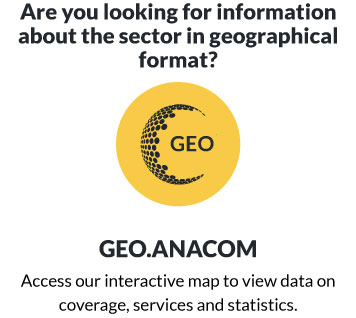2. ANACOM's analysis and position
2.1. Integration of frequencies in the RUF
ANACOM's determination of 11 September 2014, by means of which a temporary license was granted for the network consisting of transmitters located in Mendro, Palmela, São Mamede and Marofa, was taken under point 4 of ANACOM’s decision of 16 May 2013, which provides that the installation of main transmitters of the MFN network (MFN of SFNs) may be brought forward relatively to the implementation to be undertaken, further to any harmonization at international or Community levels or when a higher degree of security exists as to the need of implementation of the digital dividend 2, or also in case the operating network fails, or is expected to fail, to present the necessary stability to provide the service with the levels of quality determined in Recommendation ITU-R BT.1735-1 and future reviews thereof.
In fact, it was in a context of network instability that, in order to protect the interests of users and seeking to put in place an immediate alternative for access to a quality DTT service, ANACOM considered that it was appropriate and sufficient to decide on the use of the 4 radio channels under consideration under the regime of temporary licensing, taking into account that MEO had undertaken the commitment to apply to this Authority, by the end of October 2014, for the final integration of radio channels in the DTT RUF associated to MUX A, held by it, a commitment which the company fulfilled.
Having MEO, by letter of 30.10.2014, requested ANACOM to start procedures leading to the inclusion of the referred channels in the RUF and having reiterated, by letter of 13.02.2015, the request for final inclusion of such channels in the RUF, this Authority deems that the integration of the 4 radio channels under consideration in the RUF associated to MUX A held by MEO, in conformity with allocations/areas set out in Annex 1 hereto, is in line with the target established in the decision of 16 May 2013 as far as the evolution of the DTT network is concerned, allowing the four stations to remain in operation definitively, ensuring the necessary continuity and stability of conditions for access to the service by the population.
Points that define the areas associated to allocations in Annex 1https://www.anacom.pt/render.jsp?contentId=1372366 have been identified in determination of 24 October 20131.
1 Available at: Identification of points that define areas associated with award of DTT network development frequencieshttps://www.anacom.pt/render.jsp?contentId=1179103.
2.2. Determination of terrestrial coverage obligations
For the reasons set out in determination of 4 July 2014 and in the report of prior hearing and consultation to which the respective draft decision was submitted, ANACOM reiterates its position that terrestrial coverage obligations must be determined per municipality.
In fact, given factors to be taken into account (namely, size of administrative units, number of inhabitants and standardization and techniques for monitoring coverage), the determination of such obligations at municipality level allows for the reduction of variability as regards results of estimates and measurements of coverage conditions, at the level of NUTS I.
In addition to arguments already put forward, this Authority considers that the breakdown of the overall coverage value at the level of NUTS I in smaller units (corresponding to coverage at municipality level) improves the quality of information provided to users and citizens in general, showing in a more accurate way the effective coverage levels of the DTT network, in addition to allowing ANACOM to better assess these levels.
In short, the detail of the level of coverage of the DTT network at municipality level is considered by ANACOM to be a measure that increases the transparency of the whole DTT process, allowing for the assessment and analysis of the respective results in a more detailed way.
As such, terrestrial coverage obligations shall be set per municipality and have been included in Annex 2https://www.anacom.pt/render.jsp?contentId=1372367 to this determination, being directly associated to information in the shapefile submitted by MEO, in annex to the letter of 10 September 2015.
As regards the method for calculating estimates of the number of people with terrestrial coverage at parish level, where the product of the percentage of covered population by the number of inhabitants resulted in a number with decimal places, this number was rounded down to the nearest whole number, the population covered by DTH being obtained by subtracting the number of inhabitants by the population covered by DTT.
Together with the setting of these obligations, it is essential to establish criteria according to which it is determined that a location has DTT coverage; in this context, and considering that no radio network ensures permanent coverage, it is fundamental to define a specific period of time - degree of service availability at reception level - during which the service may not be available, an aspect which is dealt with in detail in the following section.
2.3. Degree of service availability at reception level and methodology for setting and verifying such availability
To determine whether a location has DTT coverage, it is fundamental to define the period of time during which the service is available - degree of service availability at reception level -, given that in radio networks it is impossible to ensure, due to the various factors involved, namely atmospheric phenomena that condition radio wave propagation, that a location permanently shows (100% of the time) levels that enable a quality access to that service. It is recalled, for example, that at the time of the analogue television service, the respective planning was made for 50% of the time.
According to ETSI TR 101 190 technical report1, a location is considered to be covered where the required carrier-to-noise and carrier-to-interference values are achieved for 99% of the time.
However, international standards and recommendations do not indicate the period of time2 for which the established condition of availability (99% of the time) should be observed, thus it is necessary to define it.
In order to undertake this definition, ANACOM carried out several consultations and analyses, and concluded that, although this has not been yet established nor standardized, an observation period for monitoring the quality of service of these networks, in practical terms, must take into account a minimum one-year period, so that it is statistically significant.
In the light of the above, the observation period is deemed to be one year.
To assess the degree of service availability at reception level, ANACOM will use international recommendations from reference bodies of the sector, namely the most current versions of ITU-R BT.1735 “Methods for objective reception quality assessment of digital terrestrial television broadcasting signals of System B specified in Recommendation ITU-R BT.1306” and ITU-R SM.1875 “DVB-T coverage measurements and verification of planning criteria”. It is considered that there is service availability at reception level, at a given location and in a given moment, where the probe installed (or placed) therein detects a level of quality equal to or higher than Q3, according to Recommendation ITU-R BT.1735.
Where a probe signals, for a given installation location, values for the Modulation Error Ratio (MER) values that are lower than the signal-noise relation defined for the adopted network setting (19.5 dB for a Rice channel), or a quality level lower than Q3, for longer than 3.65 days (87h and 36s), consecutively or with intervals, in the course of a one-year period, than that location will be deemed not to have DTT coverage.
According to the Report ITU-R BT.2143-23, this availability is evaluated taking into account both the transmitter status and channel conditions (interferences, reflections, etc.).
Where the means for assessing the levels of quality of service show that the coverage of population has not been ensured at percentages defined in annex 2https://www.anacom.pt/render.jsp?contentId=1372367 hereto, without prejudice to a possible procedure for administrative offences, ANACOM shall notify MEO of this fact, and this company has up to 20 working days to report to this Authority the solution to be implemented and also a proposal for provision of appropriate information to potentially affected final users, as well as the period of time deemed to be required for putting these steps in place. ANACOM may determine different time limits than those proposed.
In compliance with ANACOM's determination of 16 May 2013, the solution to be implemented by MEO, referred to in the preceding paragraph, shall consist solely and necessarily in reinforcing the SFN network coverage or in anticipating migration to the MFN network , being incumbent on MEO to ensure the levels of terrestrial coverage set out in annex 2https://www.anacom.pt/render.jsp?contentId=1372367 to this determination.
Where MEO opts for the installation of a new transmitter station to reinforce DTT coverage, it must preferably use the transmission channel provided for in the map included in Annex 1https://www.anacom.pt/render.jsp?contentId=1372366 of this Authority’s determination of 16 May 2013, namely where the main transmitter of the station under consideration is already in operation.
In addition to the update, where and as soon as appropriate, of the information at the DTT website (http://tdt.telecom.pthttps://tdt.telecom.pt/) as regards the indication of the best-server transmitter, MEO must ensure the provision of information to all potentially affected final users, according to the proposal presented and subject to ANACOM’s validation, being MEO fully responsible for any additional burdens they may incur in, namely the redirection of antennas.
Without prejudice, ANACOM reserves the right to publish assessment reports of the quality of service made available.
1 “Implementation guidelines for DVB terrestrial services; Transmission aspects” available at: ETSI TR 101 190 V1.3.2 (2011-05) Technical Report
2 A year? A month? A day?
3 “Boundary coverage assessment of digital terrestrial television broadcasting signals” available at: Report ITU-R BT.2143-2 (10/2010)
2.4. Statistical margin of error
Although ANACOM proposed in the DD a tolerance for coverage estimates - statistical margin of error - in order to meet a set of contingencies, including unintentional or random propagation phenomena, such margin was always challenged by MEO, as its assessment on the subject confirms, on the grounds that there are no international standards supporting its definition. ANACOM acknowledges the high degree of complexity in establishing a margin of error, given the large set of factors that may have an impact on the coverage estimate.
In any case, it is stressed that MEO decided, in the course of all this process, to adopt a margin of safety/implementation that is considerably wider than previously, in order to compensate in a conservative way, according to the operator, for any gaps and inaccuracies of data models in use, namely as regards the land morphology, station radiation diagrams, etc., declaring that this will make the coverage estimate much more reliable.
As such, having been addressed problems underlying the need for the definition of a margin of error in the assessment of coverage, ANACOM takes the view that it is not necessary to take into consideration any tolerance or margin of error related to the coverage estimate.
2.5. Conditions of provision of information to users
On 24.04.2013, ICP - ANACOM recommended MEO, as regards information made available at the DTT website1, that it proactively promoted, for locations initially identified as having DTT coverage and where subsequently DTH coverage was indicated, the compensation of users affected, both where the operator was contacted via call centre an where users purchased the DTH Complementary Kit.
However, and according to information currently available at ANACOM, it was found that:
- Complaints still remain on the change of information concerning the type of available coverage2, and (i) there are users affected by the referred alteration that, whether or not they filed a complaint, did not purchase the DTH kit, which in some cases could be due to imperfect information; and (ii) some of the users affected by the referred change of information only purchased the respective kits several months after the referred alteration, which could also be due to imperfect information;
- There may be users residing in areas affected by the change of information that, being unaware of this fact, do not have access to a quality television service.
Being ANACOM entitled for the purpose, reasons given above objectively justify the need for imposing on MEO a new obligation for provision of information to users potentially covered by changes of type of coverage, from DTT to DTH. In fact, while MEO is aware of affected users who have complained and affected users that in the meantime purchased a DTH kit, there may still remain a group of users that abstained from taking any action, even facing problems in the reception of the DTT service, having been concluded, from the information provided by MEO, that there is a lack of information in locations where coverage was changed from DTT to DTH.
A clear and comprehensive provision of information in this scope is of a particular importance, bearing in mind that costs incurred in or to be incurred in by any user, which would be avoided if information on coverage coincided with the coverage effectively existent, fall under the responsibility of MEO, and as such the measure is deemed to be fit for purpose.
The measure, however, must also be proportionate, so that costs that have to be borne by the company to meet this imposition do not become excessive comparatively to benefits for the public interest arising therefrom.
As such, MEO must put in place an information plan that includes an advertisement in its DTT website, in a properly distinct manner and in the homepage of the referred website, of a structured file according to district/municipality/parish/location, with the record of coverage changes from DTT to DTH, including the date on which coverage information was changed. It is deemed appropriate that the plan also integrates the delivery of a postal or electronic communication to all Juntas de Freguesia (local councils) with authority on any location, or part of locations, concerned by a change of information as regards the type of available coverage, from DTT to DTH. This plan must also clarify that, under ANACOM’s Determination of 7.4.2011, MEO is responsible for costs incurred in or that may take place further to this change of information.
1 ANACOM's recommendation of 24.04.2013 (Recommendation made to PT Comunicações as regards information provided on the DTT websitehttps://www.anacom.pt/render.jsp?contentId=1159638).
2 MEO's letter of 23.03.2015, with reference S0198 SG/2015.




